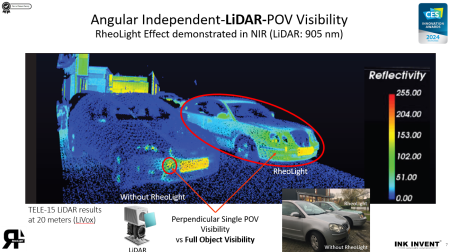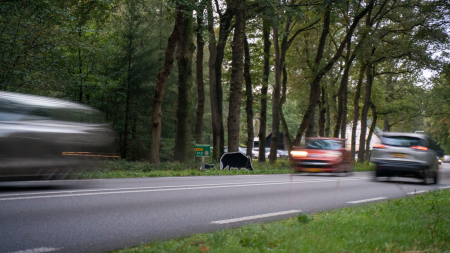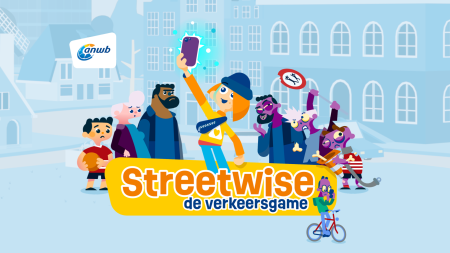Netherlands

Friday, June 21, 2024
We are solving the two main unsettled topics in Camera and LiDAR Systems and human vision in traffic situations. The internally developed Visibility Label, featuring a new universally applicable reference color, addresses the first topic, which is the lack of a universal method for quantifying the visibility of complex shapes such as cars, bikes, and busses. Crystal Glass Pigments provide a solution for the second unresolved issue, focusing on improving the functionality (i.e. visibility) of coatings on vehicles. By formulating new colors with this innovative additive, the coatings become significantly better visible for camera systems, human vision at night, and LiDAR systems 24/7.

Monday, June 17, 2024
Nature in Gelderland is thriving, with a growing number of wild animals. This is a beautiful phenomenon, but unfortunately, it also brings an increased risk of accidents involving wild animals. The chances of a poor outcome for the animal are high, but there is also a significant risk of material damage and severe consequences for the driver. The risk of collisions with wildlife is especially higher during certain periods, specific times, and at certain locations. Think of dawn and dusk, and the transition to winter or summer time.
In the past, the Province of Gelderland has taken various measures by adjusting the infrastructure and influencing the behavior of wild animals. Examples of these measures include the installation of warning signs, wildlife grids, and boar disappearance blocks. However, it turns out that more is needed to tackle the problem.
Drivers often underestimate the risk of animals being along the roads in the forests. Despite the recommended speed limits, they often drive too fast and are not always aware of the risk of animals along the roads. Therefore, the province of Gelderland wants to place more emphasis on the behavior of road users. In response to this need, creative behavioral agency andc and behavioral agency Dijksterhuis and Van Baaren have developed a behavior-oriented approach, including interventions, to encourage road users to adhere to the recommended speed limits.
In the past, the Province of Gelderland has taken various measures by adjusting the infrastructure and influencing the behavior of wild animals. Examples of these measures include the installation of warning signs, wildlife grids, and boar disappearance blocks. However, it turns out that more is needed to tackle the problem.
Drivers often underestimate the risk of animals being along the roads in the forests. Despite the recommended speed limits, they often drive too fast and are not always aware of the risk of animals along the roads. Therefore, the province of Gelderland wants to place more emphasis on the behavior of road users. In response to this need, creative behavioral agency andc and behavioral agency Dijksterhuis and Van Baaren have developed a behavior-oriented approach, including interventions, to encourage road users to adhere to the recommended speed limits.

Sunday, June 16, 2024
In the Netherlands cycling is the most important way of daily transportation. Sadly, over the past 10 years the amount of bicycle casualties in the Netherlands has increased by 40%, which is expected to increase even more by the popularity of the E-bike. In 2023, 71.000 cyclists were treated in hospitals (60% of all traffic casualties) with 12.500 having traumatic brain injury (16%). Traumatic brain injury often leads to permanent disability as neurons have no or just little recovery potential. A very simple and effective intervention is the voluntary promotion of bicycle helmet with estimated reduction of death 70% and brain injury by 60%. In Denmark, voluntary promotion of bicycle helmets has been very effective in reducing the amount of casualties, especially in children. When we started in 2022 with the first National Day of the bicycle helmet only 2% of the Dutch cyclists were wearing helmets.



Friday, June 2, 2023
The Netherlands is a country of cycling. There, the bike is an important means of transportation and elderly people are no exception to this. Cycling helps to keep people fit and included in their communities, but elderly people are unfortunately among the most at risk on a bike. The number of elderly cyclists injured in accidents has increased dramatically in the past 25 years.
The number of cycling victims with serious injuries has risen sharply in the past 10 years (40% in the period 2013-2022).
For example, the most recent figures show that in 2022, 88,800 cyclists will end up in the emergency department in the Netherlands. Of these, 57,000 cycling victims had serious injuries (VeiligheidNL). It is expected that the number of serious road injuries among cyclists in unilateral crashes will increase by 80% over the period 2018-2040. The over-65s are regarded as an important risk target group. The group aged 65 and over is growing, the share of the over 80s is growing, they are both becoming more mobile and more opting for the bicycle as a means of transport (SWOV)
Therefore, under the motto “do not get off, but keep on pedalling”, CycleOn aims to ensure that elderly people are included in the Dutch cycle network, by motivating them to continue enjoying the health and pleasure benefits of cycling while focusing on safety.
Road safety was the main motivation for initiating the project, with a focus on behavioural change rather than infrastructure. This initial emphasis on road safety quickly transformed into a broader project of promoting cycling among the elderly for the benefit of their health, happiness and social inclusion.
The number of cycling victims with serious injuries has risen sharply in the past 10 years (40% in the period 2013-2022).
For example, the most recent figures show that in 2022, 88,800 cyclists will end up in the emergency department in the Netherlands. Of these, 57,000 cycling victims had serious injuries (VeiligheidNL). It is expected that the number of serious road injuries among cyclists in unilateral crashes will increase by 80% over the period 2018-2040. The over-65s are regarded as an important risk target group. The group aged 65 and over is growing, the share of the over 80s is growing, they are both becoming more mobile and more opting for the bicycle as a means of transport (SWOV)
Therefore, under the motto “do not get off, but keep on pedalling”, CycleOn aims to ensure that elderly people are included in the Dutch cycle network, by motivating them to continue enjoying the health and pleasure benefits of cycling while focusing on safety.
Road safety was the main motivation for initiating the project, with a focus on behavioural change rather than infrastructure. This initial emphasis on road safety quickly transformed into a broader project of promoting cycling among the elderly for the benefit of their health, happiness and social inclusion.

Monday, June 13, 2022
Every year there are road casualties among young drivers. In the period of 2015 to 2019, 92 road deaths were registered annually in which a young driver was involved (in The Netherlands). The risk for novice drivers of being involved in a traffic accident is 4.5 times higher than for experienced car drivers. Of the 1 million novice drivers, half are between the ages of 16 and 24. Young people are especially vulnerable on the road, not only because of their ongoing physical and mental development (more attracted to danger, less self-control, peer influence and lower risk assessment) but also due to existing risks on the road.
Novice drivers are a risk group for two main reasons: their lack of driving experience and risky behavior that is characteristic of young people (in the form of speeding). Because of these challenges they misjudge traffic situations. However, this can be trained. TeamAlert developed an intervention including an online training, based on scientific research, targetting novice drivers.
Novice drivers are a risk group for two main reasons: their lack of driving experience and risky behavior that is characteristic of young people (in the form of speeding). Because of these challenges they misjudge traffic situations. However, this can be trained. TeamAlert developed an intervention including an online training, based on scientific research, targetting novice drivers.

Friday, June 3, 2022
Road authorities are increasingly looking for effective road safety measures driven by data in order to succeed in the Vision Zero strategy which has been published by authorities in the national ‘Strategic plan road safety 2030’.
Driving behaviour data provides an important indicator of risk of accidents and road safety. This kind of data is very helpful to analyse how drivers behave and interact with the road infrastructure. For example: where does extreme driver behaviour occur frequently? For example frequent harsh braking on a specific road section can be the consequence of the road infrastructure. Driving behaviour data supports monitoring in an effective way. It enables authorities to check how road safety measures by improving infrastructure are affected driving behaviour.
Driving behaviour data provides an important indicator of risk of accidents and road safety. This kind of data is very helpful to analyse how drivers behave and interact with the road infrastructure. For example: where does extreme driver behaviour occur frequently? For example frequent harsh braking on a specific road section can be the consequence of the road infrastructure. Driving behaviour data supports monitoring in an effective way. It enables authorities to check how road safety measures by improving infrastructure are affected driving behaviour.

Friday, June 3, 2022
As ANWB, we aim for zero road casualties in 2050. In order to achieve this ambitious goal it is of vital importance that kids start learning about road safety from an early age. The earlier they learn how to ride a bike and get safely from point A to point B the more responsible traffic participants they’ll become in the future.
We already offer an all-round educational road safety program for elementary schools throughout the Netherlands with a annual reach around 150.000 students per year. However, both teachers and parents agree that traffic education is primarily the responsibility of parents themselves and should not only happen at school. We challenged ourselves to come up with a solution that encourages kids to learn about road safety at home and offers parents tools to talk about traffic behaviour and practise concrete traffic related situations with their children.
We already offer an all-round educational road safety program for elementary schools throughout the Netherlands with a annual reach around 150.000 students per year. However, both teachers and parents agree that traffic education is primarily the responsibility of parents themselves and should not only happen at school. We challenged ourselves to come up with a solution that encourages kids to learn about road safety at home and offers parents tools to talk about traffic behaviour and practise concrete traffic related situations with their children.

Thursday, May 26, 2022
In 2020, 610 people died in traffic incidents in the Netherlands, half of them being cyclists. In 68% of traffic accidents distraction was the main cause. The usage of the mobile phone is one of the largest 'distractors'. Interpolis has a mission to eliminate traffic accidents by 2050. 77,6 percent of teenagers uses their phone on their bike. Focus groups with teenagers show that they don't realise the danger of using their phone on the bike. Moreover, research shows that they will copy this behavior when they start driving a car so there's a need to change attitude and behavior. So how do you reach teenagers who are addicted to their phone, specifically 14-17 yrs old, as they are the high risk group? And to take it a step further, how can we make them embrace a message about safety rather than reject it? Research by research company TeamAlert, assigned by Interpolis, showed us: - Teenagers (14-17 years old) are not sensitive to facts, especially when they come from 'adult' parties (e.g. insurance companies). - Teenagers are sensitive to stories from their peers. That makes it real. Therefore, YouTube and Instagram are best for safety messaging to reach teenagers - Collaborations with influencers are only effective when it's truly spot on. Teenagers are critical towards collaborations with brands. - To change behavior, it's crucial to also reach parents as conversations between teenagers and their parents is a key driver to change behavior. So, the issue should come to life from within teenagers' culture, especially through YouTube and Instagram. The most embraced culture with teenagers is Dutch hiphop, with artists seen as hero's that they listen to. But it should also touch parents and create a common ground to spark a conversation between them. To reach teenagers and parents, we created an emotional story that's recognizable to both: a first big love with all its thrills. But in this case with a sudden unhappy end, similar to reality that accidents always come out of nowhere with often terrible consequences. The story is told in a music track and a music video by one of the most popular Dutch hiphop artists and influencers, who is able to authentically carry this message. The story is based on real personal stories as research shows that stories from peers of the same age are effective in getting the attention of teenagers. The background stories are covered in a documentary. Finally, we introduce an app to help young cyclists to use their smartphone in a safe way: PhoNo. The previous app by Interpolis for smartphones and car safety, showed users make 20% less damage claims than non-users in the same risk profile. The goal was to spark massive (social) conversations between teenagers about the risks of using their smartphone on their bike. And make sure that they downloaded the PhoNo app to start cycling without distraction. Targets are: 1. Teenagers 14-17 years old and 2. Parents (to discuss the subject with their children).